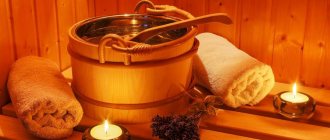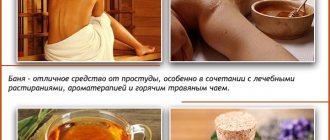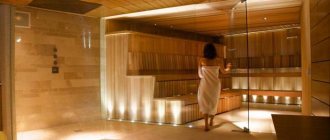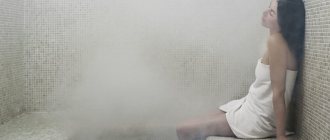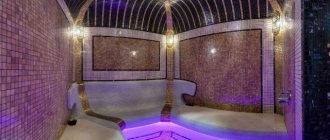Features of the Turkish bath
Hamam is unique in its temperature regime. A Turkish bath differs from a Russian bath and a sauna in that there is a high level of humidity. The air temperature here is relatively low, which creates a special atmosphere in the rooms where it is easy and pleasant to be around. The establishment is distinguished by special bathing procedures carried out by bathing specialists. Here they practice soap peeling, oriental massage with cosmetic oils, and tea drinking. Tiles and stones are used to design the premises, while the walls of baths and saunas are lined with wood.
Temperature in the hammam
This aspect is the main difference between a Turkish bath and a Russian one. With high air humidity (maintained at 100 percent level), the temperature in the rooms does not rise above 50 degrees. This is optimal for people who are prohibited from visiting the sauna for health reasons. The combination of this temperature and high humidity has a healing effect on the body. This promotes gentle cleansing of the skin and normalization of all processes. The air temperature of a standard sauna is kept at 100-120 degrees, humidity is 10-15%.
Steam supply
The building is heated by one large boiler. Hot steam is supplied from it through pipes laid under the floor. It penetrates into the premises through holes on the walls made at a height of 1.5 m. In the sauna, to create steam, water is splashed onto hot stones, which does not provide a uniform supply. In the hammam, due to the device, everything is heated equally: walls, floors, sun loungers.
Temperature
Hammam is one of the most gentle bathing procedures. The air heating temperature, depending on the room, here varies from +30 to +60 degrees Celsius. The heating process occurs gradually, without “shock therapy”, with a gradual opening of the pores. In this case, the humidity level varies from 80 to 100%. When building a Turkish bath, it is necessary to observe the correct temperature transitions when changing rooms. The hammam resembles a gallery, each room of which has its own heating mode:
- + 28-30 – degrees in the locker room;
- + 40-50 – indoor soguklyuk with sun loungers;
- +40-50 – on marble benches chebek-tashi;
- up to +70 - in niche steam rooms, the temperature in them is different, for every taste.
The history of hamams
Baths of this type appeared in Turkey at the beginning of the seventh century and implied a special culture of ablution, adopted from the Arabs. The latter borrowed the technology and architecture of Roman terms. When Islam came to the eastern countries, hamams became popular. Distributed in Turkey, Arab countries, Azerbaijan, Afghanistan, Iran, and Central Asia. Traditionally it is believed that a hammam is a public institution for ablution. The name comes from the word “ham”, which means “hot”.
The interior decoration was luxurious, because ablution was declared an obligatory action by the Prophet Muhammad, who said that “Cleanliness is half the faith.” It was believed that you can get true pleasure in a Turkish hammam. Roman baths and temples left over from other religions were often converted into them. Women's baths were placed next to men's, with one source of heating (boiler) and water supply, but different entrances. Sometimes there were not enough funds for this. Then they set up one building and declared certain “women’s” days there.
Arrangement of premises
A classic ancient hammam - a large building with many main and utility rooms. Everything was heated by a huge boiler of water, which was located under the floor. Holes for supplying hot air were located in the walls of the paired rooms at a height of one and a half meters. Special conditions inside are created due to the proximity of the heating boiler and the pipes running under the floor.
The classic hammam, according to a long-standing tradition, was built in the shape of a human hand with rooms of different sizes. In the center, in place of the palm, there is a steam room. There are five separate rooms around, which symbolize fingers. The dressing room is a prototype of the hand. The temperature here is no higher than 35 degrees, the room is intended to prepare the body for the ritual, to warm it up.
Five corridors lead from the steam room to other rooms (symbolizing the fingers of the hand). Each room has a different temperature, you need to visit them in turn. This helps create a safe load on the body and remove toxins. Due to the special way the boiler is located, the floors in all corridors and rooms are very warm, so moving around them is incredibly comfortable. Purpose of the premises:
- Jamekian. The locker room is where shoes and clothes are taken off and a body bandage is put on.
- Pestemal. The room where visitors take a shower.
- Chebek. Body preparation room. There is a bed made of natural marble “chebek-tashi”. You need to lie on it with your stomach down. There are multi-stage benches.
- Hararet. The main steam room is round in shape. Designed for deep cleansing of the skin. Here they do peeling, intense soap and oil massage.
- Keif. Here after the procedures they relax and drink herbal tea.
After passing through all the rooms, according to legend, the body is cleansed. Then you should visit the steam room again for a massage session, which should be performed by oriental masters. The movements they perform may seem very rigid, especially to those who are undergoing the procedure for the first time. But Turkish massage perfectly relaxes, relieves fatigue, invigorates, and helps clarify the mind. After the session, you need to wash yourself with a hard washcloth and swim in three pools with water of different temperatures.
Hammam for the bride
In ancient times, when women's rights in Turkey were severely limited, they perceived the hammam as a place where they could breathe a breath of fresh air. Something like a modern beauty salon. Separate baths were built for women or special days were allocated during which entry for men was prohibited.
Representatives of the fairer sex took going to the bathhouse very seriously. They took cosmetics, mirrors, combs with them and spent several hours there - drinking tea and coffee with sweets, gossiping. There, mothers-in-law looked for brides for their sons.
There is an interesting custom of the pre-wedding hamam - when relatives on the husband’s side take their future daughter-in-law there. The girl is put on a special costume, songs are sung and she is evaluated from all sides. This tradition is still preserved in some villages in Turkey.
In addition, from time immemorial, joyful events have been celebrated in the hammam - the birth of a child, a major purchase, the fulfillment of a wish. The hero of the occasion organized a feast, hired musicians, and the guests danced and had fun.
Of course, not all modern hammams are authentic. These days, especially in tourist areas and five-star hotels, they are more like spas. If you want to join the ancient traditions of oriental baths, go to specialized establishments.
Modern Turkish steam room in classic style
Today it is difficult to find a hammam where all the procedures required by tradition are carried out. You can find baths that are as close as possible, perhaps, in Istanbul or Bukhara, but in most resort cities they are not at all similar to the old ones. To increase the temperature, steam generators are used, which are disguised by the interior decoration. Hamams are intended for public ablution, and this is no longer relevant for Arab countries.
Modern Turkish baths are small, because it is almost impossible to find a suitable place for the construction of traditional-sized rooms. A trend towards a revival of the idea has emerged in Russia in recent years. Modern establishments are becoming more and more similar to traditional ones. Many health centers and sanatoriums offer Turkish-style ablutions to their clients.
Modern hammams consist of only three rooms. The approach to the construction processes and selection of materials has been significantly simplified. If earlier buildings were made entirely of stone, now ordinary brick is used. The interior decoration is done in oriental style. The use of natural stone is encouraged. A modern Turkish bath consists of rooms for preliminary preparation (locker room), steam room (harareta), and cooling. Each room has its own characteristic features.
Locker room (jamekian)
This room resembles a traditional dressing room. Here a person must remove all clothes and shoes. Then here or in the next room (depending on the structure) they take a warm shower. This is how the body undergoes primary cleansing and prepares for other procedures. They walk into the next room wearing only a body bandage. It is important to note that the latter should be made exclusively from natural materials, for example, silk or cotton.
Steam room for hot baths
Hararet is a sacred place. This is a large round room with a lot of free space. They take hot baths there. First comes the steaming procedure to open the skin pores. This is followed by ablution with a coarse washcloth made of natural goat hair. Alternate rubbing and rinsing with warm water. After this procedure, it is proposed to visit the third room, where the body will regain strength after the stress it was exposed to under the influence of high temperatures.
The ceiling of the steam room deserves special attention. It is made in the shape of a dome and must be at least three meters in height. This is necessary so that condensation does not accumulate on top, it does not drip onto the floor and visitors to the hararet, but flows down the rounded walls and ends up in the drainage system. Lamps corresponding to the general stylistic design are mounted to the ceiling. Lighting should be bright, but not annoying.
Soguklyuk for cooling and restoring the body
In this room the temperature is lower than in the others, about 30-35 degrees. Here the body cools down and recovers after exercise. There are showers here. After massage and other procedures, a visit to this room is mandatory. As a rule, in a room to restore the body and cool down, you can not only lie down and relax, but also drink aromatic tea and enjoy oriental sweets.
The procedure for constructing a hammam in stages
After completing the construction of the hammock building, you can move directly to the layout of the interior of the Turkish bath.
Thus, the technology for creating ham consists of the following levels:
- thorough thermal insulation with foil coating;
- protection from moisture;
- installation of a heating system;
- laying screed and final waterproofing;
- decoration.
Thermal insulation
High-quality insulation work for the hammam will ensure efficient energy consumption when heating the premises, as well as prevent heat loss.
For high-quality implementation of thermal insulation, expert recommendations on methods and techniques for performing such work must be studied in detail.
Moisture protection
The humidity level in a hammam is always higher than in a bath.
And moisture accumulates in significant quantities up to the ceiling and walls
Therefore, in order to avoid unpleasant consequences in the form of mold and other complications, it is important that waterproofing work is carried out efficiently. The general principle for implementing such manipulations is the same as for hammams and bathrooms
Heating system
To maintain the optimal temperature in your Turkish bath, you can use different heating systems, which are ideal for water and electricity.
If a common heating system is installed in the house for heating water, it can be connected to a heating chamber or a separate boiler in the technical space. There will also be a steam generator.
But in the case of electric heating, the best option would be a “warm floor”. In this case, heating mats should be placed not only on the floor, but also on the walls, as well as on the central pedestal, as well as on stone floors, depending on what is placed in the Turkish bath.
For safety reasons, the electric heating control panel should be placed in a technical space or rest area.
decoration
If we are talking about classic Turkish baths, even natural marble was used for the stove. However, this opportunity is too expensive in the current situation. Therefore, a quality alternative is small mosaic ceramic tiles.
This has almost no effect on the basic properties of the hole and will cost much less.
In addition, small tiles in a mini-hamam will not visually reduce the space. To create the most authentic atmosphere, it is worth choosing a memorial plaque with oriental decorations.
light
As in a Turkish bath, condensation accumulates on the ceiling and the humidity level is very high, lightweight devices with special protection must be provided.
In accordance with safety standards, the level of protection of connectors and lighting devices must be at least IP 65.
Additionally, the electrical cable you install must have a heat-resistant braid as there are significant temperature variations in a Turkish bath.
How to take a steam bath in a hammam
Ablution is a whole ritual, which is a clear sequence of actions. If you want to make the most of your visit, you should definitely go through all the stages. How to steam properly:
- In the locker room you need to take off your clothes, take a shower at room temperature, and stay for about a quarter of an hour so that the body gets used to the conditions and the pores begin to open.
- Visit a warm room. Stay there until the first drops of sweat stand out.
- Then you should go to the marble hall. Here you need to sit on a warm lounger with your stomach down. The attendant will rub you with a special scrubbing mitt. This is followed by several rinses with warm and cooler water. This sequence of actions will ensure high-quality skin peeling. Then intense soaping occurs.
- The foam from olive soap, whipped with special “pillowcases”, will cover every centimeter of your body. This is the most enjoyable stage among all the others.
- After rinsing your body, you should plunge into the pool or jacuzzi. This is very invigorating and helps the pores close.
- Then it’s time for relaxation. You can drink green tea with spices, lie down with a clay mask on your face.
- The final stage is a massage with natural oils.
Rules for visiting the hamam
There are several traditions that are very important to observe. Basic rules for visiting a Turkish bath:
- There are separate rooms for women and men.
- Before going for the procedure, avoid drinking alcohol, fatty, fried and other unhealthy foods. This can put additional stress on the body and make the ablution session seem too difficult.
- Be sure to wear a sarong or tie a sheet around your body. You need to take care of its availability in advance. It is not acceptable to be naked here.
- You must place a towel on the massage bench before lying down.
- At the end of the procedures, you should not stand up suddenly, because heated muscles can be damaged.
- For a full course of ablution, it is recommended to spend at least one and a half hours in the hammam.
Massage treatments
Manipulations of this nature are performed by specially trained oriental specialists. For some, the massage may even seem too harsh, especially if a person is visiting the bathhouse for the first time. The procedure is incredibly beneficial not only for the body, but also for the mind. After it, a person feels complete relaxation, followed immediately by a surge of strength and emotional uplift.
- How to take activated charcoal to cleanse the body. Proper intake of activated carbon
- Mexidol - instructions for use, analogues and reviews
- Hemlock - medicinal properties and contraindications. How to take hemlock tincture to treat illnesses
How often can you visit
In this matter, you need to be guided by your own capabilities and state of health. To maintain tone, it is optimal to visit the establishment once a week. You should stay in the bathhouse for at least an hour and a half, but it can be longer if your health allows. For example, women used to be able to spend the whole day there. They not only went through procedures, but also communicated, exchanged news, and drank tea and treats.
Turkish hammam: a brief history of origin
Turkish hammam
The first mention of a Turkish steam bath appeared at the very beginning of the 17th century. Although some sources claim that hammam appeared much earlier. This is due to the fact that there is an opinion that the Turkish hammam is the most improved copy of the ancient Arabic soap houses.
It is believed that even the word “hamam” itself has Arabic roots and comes from the word “ham”, which when translated into Russian sounds like dispersing steam. Before the official announcement of Islam, steam rooms were not particularly popular; most often they were visited by financially secure people. But after the great Muslim prophet Muhammad emphasized the importance of regular cleansing of the body, people from absolutely all walks of life began to strive to visit the hammam.
Over time, its popularity became so great that days had to be officially divided between the poor and the rich, as well as women and men. Thanks to such popularity, the Turkish hammam has become an important part of Eastern culture. Coming here, people had a hard time washing and steaming, they relaxed, discussed the latest news and even got to know each other.
The benefits of hamam
Regular visits to the Turkish bath have a beneficial effect on the body. What is the effect of ablution?
- Helps cleanse, moisturize and tighten the skin, normalize the functioning of the sebaceous glands, and eliminate acne. This is achieved due to high humidity levels. Oily and sensitive skin is well cleansed, while dry skin is softened, becomes elastic and toned.
- Relieves fatigue, stress, helps fight depression and insomnia. Positively affects the nervous system.
- Rejuvenates. When bathing, a person’s metabolism accelerates and the intensity of oxidative processes increases. This helps rejuvenate the body.
- Removes toxins and waste from the body.
- Facilitates well-being in diseases of the musculoskeletal system. Regular visits for osteochondrosis, rheumatism, arthritis or muscle strain help to significantly reduce the pain caused by these diseases.
- Improves blood circulation. Congestion is eliminated. Vessels and capillaries dilate, the outflow of blood from internal organs increases.
- Increases immunity.
- Promotes a speedy recovery from rhinitis and bronchitis. If a person often suffers from colds, steaming is very useful for him. It is easy to breathe in the rooms due to the volumetric area of evaporation. Prolonged warming of the body improves immunity and helps resist ARVI.
For a cold
If a person does not feel well, it will be useful for him to visit a Turkish bath. This will immediately ease the discomfort caused by malaise, sore throat, and runny nose. Steaming is prohibited if body temperature is high. You are not allowed to dive into the pool or take a cold shower. How Turkish hammam is useful for colds:
- Warm, moist air reduces pain in joints and muscles.
- Bathing has a positive effect on the functioning of the respiratory system.
- The hammam bath ionizes the body and increases its protective abilities.
- Due to the moist air, when you have a runny nose, mucus comes out easier and the spread of inflammatory processes stops.
For sinusitis
Specific temperature and humidity cause positive changes in the body. For sinusitis, you can visit the bathhouse during periods when there are no signs of intoxication and high temperature. It is better to go for a steam bath during the recovery stage. Washing speeds up the process and strengthens the immune system. Hot and humid air in the steam room will help reduce swelling of the mucous membrane of the maxillary sinuses; it will regenerate faster. The discharge will become less abundant. Rules for visiting for sinusitis:
- During recovery, you can go to the bathhouse twice or thrice a week. The procedure takes no more than half an hour. You need to constantly monitor your well-being.
- For chronic sinusitis in remission, you can visit the bathhouse every day. It is better not to stay there for too long; the optimal stay time is 15-45 minutes. There should be no complaints about your health.
Hammam for weight loss
People who want to lose excess weight will find it very useful to visit a Turkish bath. In one session you can get rid of 1-2 kg. The effect will be more noticeable if you combine bathing with tea, and do an intense massage. Many nutritionists recommend going to a Turkish bath as part of a set of weight loss measures. How does the procedure affect a person’s weight:
- Heat exchange slows down, causing metabolic and oxidative processes to accelerate.
- Pores open and sweating increases. Toxins, waste, harmful substances and excess fluid are actively removed from the body.
- Metabolism accelerates, subcutaneous fat accumulations are broken down.
- Intense soaping and massage help eliminate cellulite.
For bronchitis
If the disease has entered the recovery stage and the acute phase has been stopped, then moist air will be beneficial. For bronchitis, it is allowed and even useful to visit a Turkish bath. The exception is when the body temperature rises above 37 degrees and severe shortness of breath appears. If there are no contraindications, then you can visit the hammam, strictly following the following recommendations:
- Before entering the steam room, drink plenty of warm herbal tea. This will help the body warm up from the inside.
- Breathe deeply indoors to help remove mucus.
- Do not leave a warm room into a cold one, do not dive into a pool. The body should cool down gradually. Otherwise, the disease may recur.
For acne and pimples
Regular visits to the Turkish bath promote skin regeneration and cleansing. During the procedures, dead cells are removed, and the functioning of the sebaceous glands is normalized. This helps improve your appearance. In addition, during bath procedures, toxins are removed from the body, which often cause acne and rashes. The condition of the skin and the peeling are improved.
Turkish hammam: procedures for rejuvenation and weight loss
Procedures for rejuvenation and weight loss
As mentioned above, the Turkish hammam is a unique place, with the help of which you can improve your health as much as possible. Moreover, regular visits to this place will contribute to noticeable rejuvenation, as well as weight loss. True, in order to achieve such a result, it is necessary to alternate visits to the steam room, intense massage and relaxation with tea drinking.
As practice shows, in two such approaches you can lose up to 2 kilograms of weight, get rid of puffiness, moisturize the skin and make it fresher and tighter. To carry out such procedures, it is best to use tangerine, orange and lavender oils, natural olive soap and black Moroccan clay. All these tools can be included in a classic massage and heal your body without much effort.
IMPORTANT : If you do not want to harm your body, make sure that the procedures do not last more than 2 hours
Harm from hamam
Moderation is good in any activity, and a visit to the Turkish bath is no exception. In some cases, staying in it can harm the body, so you need to treat this with caution, take into account all contraindications, and follow the rules. Possible negative consequences of visiting the bathhouse:
- Pregnant women are not recommended to take a steam bath. High temperatures can harm the fetus.
- People with mental disorders, oncology, or skin diseases should not go to the hammam.
- You should not steam during any acute inflammatory process.
- If you have severe lung diseases, you should not visit the bathhouse. It will be difficult and even dangerous for a person to stay in such a humid environment.
- People with cardiovascular diseases should not be in the steam room. This will overload the body, which will negatively affect the condition. Those with hypertension should also be careful when using the steam room. Moist hot air can cause an increase in pressure. At the same time, normalizing the condition will be problematic.
- In case of high temperature and viral diseases, ablutions will only worsen the condition.
- Staying in a warm, humid room promotes the growth of fungus. People with any manifestation of this disease should avoid hamam. In addition, visiting public bathing areas by people with a fungal infection is unethical in relation to others present there.
Hammam wraps
Wraps
They are also in demand due to the fact that they provide a quick weight loss effect, but they also work in combination: with physical education, massage and a balanced diet. For cellulite, wraps with green coffee and kelp - live algae - are very effective.
Coffee wrap
promotes the removal of toxins and the breakdown of fats, moisturizes the skin and activates cell renewal.
For wrapping with kelp
Ecologically clean living algae are used, famous not only as a product with a cosmetic effect, but also as a remedy for curing many diseases. Vitamins, macro- and microelements, found in abundance in them, help to establish material metabolism and keep the skin young and elastic. At the same time, the fresh aroma of seaweed reminds of the sea, promotes relaxation and tranquility.
Contraindications for visiting
Not all people are allowed to take a steam bath in a Turkish bath; sometimes health conditions prohibit it. Contraindications for visiting are:
- severe bronchial asthma;
- heart disease, hypertension;
- epilepsy;
- thyroid dysfunction;
- cancer;
- phlebeurysm;
- open wounds, irritations, abrasions, scratches on the skin;
- inflammatory processes in the kidneys.
Hammam for varicose veins
This diagnosis, like other diseases of the cardiovascular system, is a contraindication for visiting a Turkish bath. High temperature negatively affects people with this diagnosis. Because of it, the vessels dilate and the volume of circulating blood increases. The load on the veins increases several times. This is an extremely dangerous condition with varicose veins. Even if precautions are taken, visiting the hammam is prohibited if you have this disease. Doctors confirm this.
For bronchial asthma
People with this diagnosis are strictly prohibited from visiting the hammam. This can provoke new attacks and worsen an already dangerous situation, especially if the disease is severe and has complications. In some cases, doctors give the go-ahead for asthmatics to visit the hammam at the initial stage. Some patients benefit from moist and warm air in the bathhouse, because under its influence the volume of the lungs increases and the number of attacks decreases. Visiting the steam room in this situation is allowed only under the conditions recommended by the attending physician.
What procedures are typical for a hammam?
When visiting the hammam, in the locker room you will be given overalls - a large towel to wrap yourself in (it is not customary to bathe naked in a Turkish bath), and slippers with wooden soles. Then you will go to the main hall, where, lying on a stone lounger, you will warm up for 15-20 minutes. During this time, the skin pores will open and natural cleansing will begin. To enhance the cleansing effect, the skin is peeled using a hard mitten made of camel hair. In a traditional hammam, this procedure is performed by the bathhouse attendant, who rubs the visitor’s body and at the same time gives a light massage.
Next in line is one of the most pleasant procedures - soap massage. The bathhouse attendant whips up soap foam in a large bag (like a pillowcase) and applies it to the visitor’s body. In this case, only natural soap is used, made according to special recipes based on vegetable oils (peach, olive, jojoba, etc.). After this, the bathhouse attendant begins a relaxing massage, which can last from 10 to 30 minutes.
Soap massage and peeling are mandatory procedures in the hammam. However, besides this, you can be offered much more: oil massage, honey massage, various masks.
More information about massage in the bathhouse can be found here:
After all the procedures, you can go into a cool room, drink green or herbal tea with oriental sweets and relax. Only after you feel that your body has cooled down and acquired a normal temperature, you can get dressed and go outside.
Improved appearance is another plus of the procedure
Photo of the Red Lake Detox Clinic
Heat, humidity, temperature contrast improve skin trophism, affect microcirculation, stimulate its protective, metabolic, and regenerative functions. Under the influence of heat, the pores on the skin expand; during procedures (cleansing and peeling), the skin is cleansed, moisturized and tightened, the functioning of the sebaceous glands is normalized, and acne disappears. Improving metabolic processes promotes rejuvenation, the skin becomes soft and elastic.
By the way, unlike other types of baths, in the hammam the hair is not at risk of drying out, which is important if it is brittle and dry. Moreover, soft steam normalizes blood circulation in the scalp, stimulating hair growth and improving its appearance.

